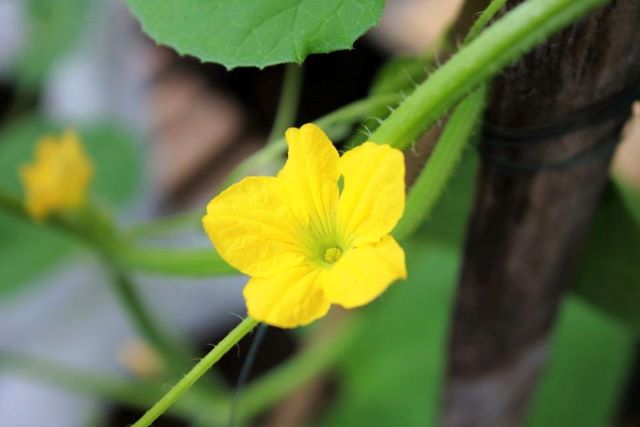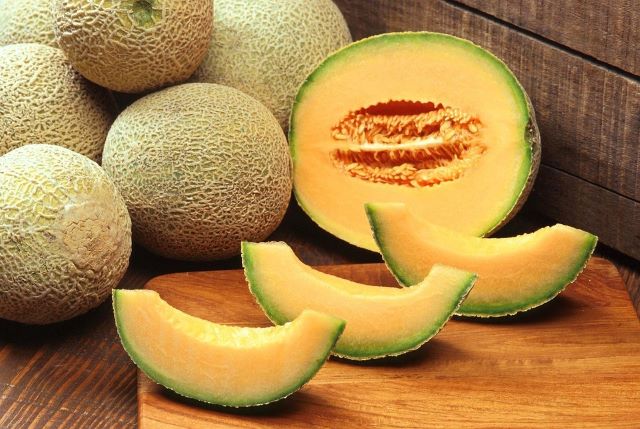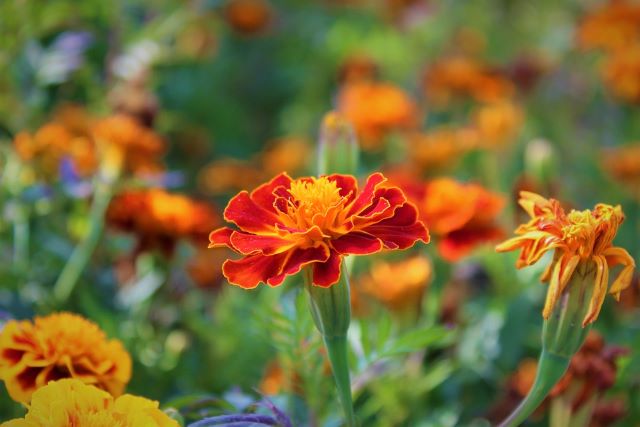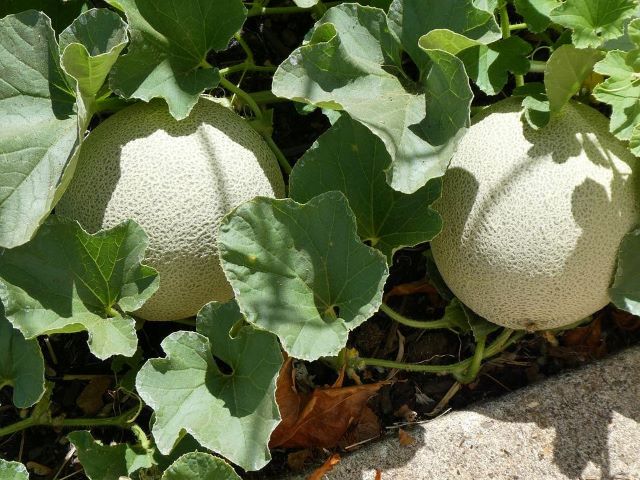If your cantaloupe plants are flowering but not producing fruit, you’ll want to know why. After all, ripe cantaloupe is a delicious summer fruit, and it can be frustrating to see flowers but not get any fruit.

There are only a few common reasons why cantaloupes might flower but not fruit. In this article, I’ll talk about each of those reasons, as well as what you can do about them.
The three common reasons for cantaloupe flowering but no fruit are an imbalance of male to female flowers, nematodes, and lack of pollination.
So what do you do about each of these? Let’s take a look so you can grow an abundant harvest of cantaloupes.

Table of Contents
Cantaloupe Vines Producing Too Many Male Flowers Cause Lack of Fruit
Cantaloupes have three types of flowers: male, female, and “perfect.”
It’s fairly easy to tell the difference between male and female cantaloupe flowers: females have a small bulge beneath the flower, which will turn into a melon once pollinated. Female flowers have a short stigma, while male flowers have a long stamen.
Most cantaloupe plants will also have some “perfect” flowers, flowers with both male and female parts. These flowers are usually self-pollinating.
Sometimes, your plant will have a lot of male flowers, but no female ones. Obviously, without female flowers, the plant can’t produce cantaloupes. So check to see what flowers you have.
Usually, male flowers will appear first, with female flowers appearing a few days or even weeks later. Bad weather, like a lot of rain, can sometimes cause female flowers to appear even later. If you have a lot of male flowers, you might just have to wait a little bit longer until female ones appear.
However, high temperatures can also cause cantaloupes to not produce female flowers. The ideal growing range for cantaloupe is between 65-95 °F (18-35 °C). If it gets hotter than this, the cantaloupe vine might only produce male flowers.
To help prevent this, make sure you plant cantaloupe early enough, and that they have enough time to properly flower before it gets too hot. And if the temperature is good, you might just need to wait a little longer for female flowers to show up on the plants.
Nematodes Cause Cantaloupe Flowers But No Fruit
Nematodes are a pest that can cause a lot of problems for cantaloupe. The common variety that affects melons is called root-knot nematodes because they cause a disease known as root-knot.
Root-knot can cause cantaloupes to not fruit, meaning you would have a lot of flowers but no fruiting. The signs of root-knot are wilting in the afternoon even with proper water, as well as yellowing and stunting of the plant.
If the nematodes come late in the season, your cantaloupes can survive, they just may not fruit. However, if the infestation starts early and grows, it can kill your cantaloupe plants.
Nematodes live in the soil and are often a pain to get rid of. Try to prevent introducing them to your garden by only buying plants from trusted nurseries, and making sure your soil comes from a good source. Additionally, don’t move soil or plants from one area to another, to help prevent them from spreading.
Rotating cantaloupe planting location helps, so you don’t have potential host plants in the same soil for more than one year. Additionally, you can till the soil frequently, and plant a cover crop of cereal rye or wheat for the winter. In the spring, cut down the crop and till it into the soil before planting your cantaloupes. This will help kill off nematodes and prevent them from multiplying.
You can introduce ‘good’ nematodes known as beneficial nematodes like these ones. These little miracle workers are a natural biological control against the ‘bad’ nematodes but also many other garden pests. They’re safe to use in the organic garden and will help you to garden more naturally by getting rid of pests safely.
Planting Marigolds to Control Nematodes

If your nematode infestation is a serious one, think about a natural method of control that involves planting marigolds. This is a slightly long-term approach because it requires you to grow the marigolds first but it is effective.
You can either sow marigold seeds like these or simply dig mature marigolds into the soil and keep the soil moist for around three weeks. Do not allow the soil to dry out. During this time, the marigolds will release plant gases that work to kill off the nematodes.
This natural method is highly effective and well worth the effort to control a nematode infestation using organic gardening techniques.
Lack of Pollination Cause Cantaloupe Flowers But No Fruit
The most common reason why cantaloupes will flower but not fruit is that they aren’t getting pollinated. While perfect flowers don’t need external pollination, the other female flowers on the plant do.
Of course, there’s no substitute for bees when it comes to pollination. They are the most reliable way for your cantaloupes to be pollinated. So you should do what you can to encourage bees to stay in the area.
This often means planting flowers that bees enjoy. Lavender, dandelion, lilac, and dozens of other wildflowers are great pollinator attractors. You can create a beautiful flower patch as a complement to your cantaloupe garden.
Certain things make it more difficult to have bees around. Pesticides or insecticides that can harm bees should be avoided, and even if your neighbors are using these on their flowers, it can affect the bees in your garden.
Additionally, if it’s raining, bees aren’t going to go out and do their work. So if you know there are bees in the area, but there’s been a lot of rain, that could explain why they’re not pollinating your plants.
Hand Pollinate Cantaloupe Flowers
If the bees simply aren’t helping enough, you can also pollinate your cantaloupe by hand. This is fairly simple but does require care.
First, get a small paintbrush to use for the job. It’s best to do this early in the morning, on a day when it isn’t raining, as this is when you will have the most success.
Identify the male, female, and perfect flowers on your cantaloupe plants. You can leave the perfect flowers be, but following this process can also help them pollinate more easily if you want to.
Go to a male flower, and use your brush to gently swab the inside of the stamen, moving in small circles to cover the brush in pollen. Then, take the pollinated brush to the stigma of a female flower, and gently brush the pollen all over. One male flower can pollinate multiple female flowers, although it’s best to limit the job to no more than four.
Then, your flowers should be pollinated and ready to turn into melons! You may have to repeat this process as more flowers appear on the plant. Soon after, you should notice the bulge at the base of the female flowers starting to grow larger and turn into a cantaloupe.

Remember, pollination is the most likely culprit for cantaloupes not flowering. But before you hand pollinate, you should rule out the presence of nematodes (noticeable by problems with the plant), and make sure that you have both male and female flowers. Then, enjoy your delicious harvest!
Some Favorite Gardening Products
- Ambrosia Cantaloupe Seeds and Hale’s Best Melon – Cantaloupe Seeds
- Marigold Seeds
- Wildflower Seeds
- Beneficial Nematodes
- Felco Garden Pruners
- King Bird Raised Garden Bed
Further reading:
- Why Is My Cantaloupe Sour? Answered!
- Strawberry Plant Flowers But No Fruit: Causes And Solutions
- Why Blueberry Bush Flowers But No Fruit (With Solutions)
- Watermelon Plant Dying? Causes and Solutions
- How to Grow Watermelons: Planting, Caring and Harvesting Watermelons
- Watermelon Flowers But No Fruit? Causes and Solutions
